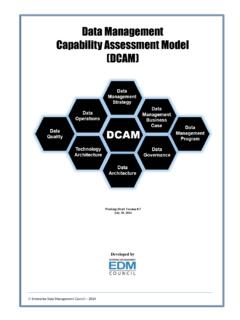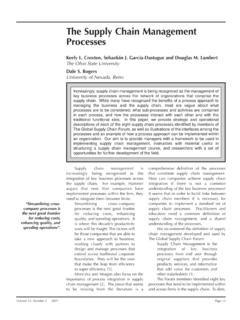Transcription of Measuring the Business Value of Data Quality
1 G00218962. Measuring the Business Value of data Quality Published: 10 October 2011. Analyst(s): Ted Friedman, Michael Smith Research shows that 40% of the anticipated Value of all Business initiatives is never achieved. Poor data Quality in both the planning and execution phases of these initiatives is a primary cause. Poor data Quality also effects operational efficiency, risk mitigation and agility by compromising the decisions made in each of these areas. Key Findings Poor data Quality is a primary reason for 40% of all Business initiatives failing to achieve their targeted benefits. data Quality effects overall labor productivity by as much as a 20%. As more Business processes become automated, data Quality becomes the rate limiting factor for overall process Quality .
2 Recommendations Business leaders and IT leaders focused on data Quality improvement and information governance should: Measure the Business Value of improved data Quality by focusing on Business processes , investment decisions and overall productivity. Qualify the Business Value of improved data Quality using Business metrics that are correlated with financial outcomes. Share the findings of this research with your finance department to receive feedback and guidance on where to begin identifying opportunities for increased Business Value from improved data Quality . Table of Contents The Impact of data Quality on Business The Impact of data Quality on The Impact of data Quality on Decision Process for Measuring the Specific Business Value of data Example of Measuring Business Value of data Bottom Recommended List of Figures Figure 1.
3 The Productivity Benefits From Figure 2. The Gartner Business Value Analysis Organizations are discovering that data Quality deficiencies have a significant impact on their most strategic Business initiatives, often holding them back from achieving the growth, agility and competitiveness that they desire. In addition to challenges with growth and agility, compliance and transparency pressures increasingly bring data Quality issues to the fore it is no longer acceptable to ignore flaws in data , and organizations must prove the accuracy of information that they report to auditors, regulators and the public. Given the current economic challenges and budgetary pressures facing most organizations, there is a substantial desire to eradicate Quality issues in data as a way to reduce costs and improve efficiency (see "Findings From Primary Research Study: Organizations Perceive Significant Cost Impact From data Quality Issues").
4 Historically, a minority of organizations have taken a proactive approach to managing data Quality the majority have endured the pains of poor- Quality data and dealt with it in a reactive manner. However, with recognition of the impact of poor- Quality data increasing as a result of all of these contemporary Business drivers, many are undertaking improvement efforts within the context of individual projects or occasionally on a broader, enterprisewide basis. They can address these challenges through the discipline of data Quality , which includes the approaches, organizational models, techniques and technologies used to assess and ensure the "fitness for purpose" of all types of data for use by the various applications and Business processes across the enterprise (see "Key Issues for data management and Integration Initiatives, 2010").
5 While technology plays a key role in data Quality improvement, changes in work processes and behavior of people are critical. The demand for data Quality best practices is maturing more organizations are focused on fine- tuning their efforts by increasing the precision with which they measure and monitor data Quality , the breadth of their scope (looking across multiple domains, processes and groups) and creating data Quality -specific roles and organizational structures. Tools for Measuring , monitoring, and Page 2 of 12 Gartner, Inc. | G00218962. improving data Quality can help enterprises improve effectiveness and deploy controls in approaching data Quality challenges. How can CIOs and CFOs quantify the impact on their organizations?
6 Each organization is different, but many different examples can be seen across a variety of industries (see Note 1). CIOs can use similar examples that are relevant to their organization to quantify the financial impact of improving data Quality and gain buy-in from Business leaders in sales, marketing, customer service and other parts of the organization. One of the new realities of the global economic environment is the desire of Business executives to manage risk more effectively. This has created the need to shift from "gut-feel" to fact-based decision making (see "Survey Analysis: How Executives Use Business Metrics"). Gartner conducted a survey of Business executives before and after the financial crisis of 2008.
7 The results showed a 30% increase in the use of Business metrics as the basis for setting strategic direction. So what is the measurable impact of data Quality ? The Impact of data Quality on Business processes The effects of data Quality on Business processes can be estimated based on Six Sigma. Harry and Schroeder estimate that the average successful Business process maintains sigma Value (see Note 2). This equates to 22,800 defects per million. At this rate, the average cost of Quality is 20%. of the overall Business process costs. For example, if the Business process were sales and a company spent $200 million to maintain its sales process throughout the year, then at sigma the cost of Quality would be $40 million annually.
8 In the past 10 years data Quality has begun to set the basis for process Quality . Business processes are becoming digital. Over the past 10 years, information technology has been used to automate transaction that go well beyond accounting. Automation of sales, product development, manufacturing, and recruitment processes , to name a few, is expanding each year to lower costs. When processes are automated to the maximum extent possible, data Quality issues become the limiting factor in maximizing process Quality . Consider the following example. A $10 billion consumer goods distribution company recently implemented a sales force automation system. All leads, qualified leads, sales resources, and campaign strategies are recorded in the system.
9 The Quality of prospect and product data are critical to the overall Quality of the sales process. data Quality defects become process Quality defects as mistakes are made when data is wrong. It does not take much. To maintain average process Quality of sigma, data Quality must remain below 22,800 defects per million, or , in highly automated processes such as automated material handling systems. The 20% cost of Quality results from flaws in data . In effect, data Quality becomes the limiting factor in process Quality . The Impact of data Quality on Productivity The top half of Figure 1 shows the impact of information technology on overall labor productivity in the for the past 10 years. The Bureau of Labor Statistics estimates that 70% of the annual productivity growth of , or , comes from IT.
10 This is the good news; the bad news is Gartner, Inc. | G00218962 Page 3 of 12. shown on the bottom half of Figure 1. The productivity benefits are not shared equally; in fact, there exists substantial variation. Why is it that one enterprise can benefit while others do not? Figure 1. The Productivity Benefits From IT. "IT is correlated with Productivity (Relative to Industry Average). productivity, but there are substantial variations among companies.". IT stock is measured as the current replacement cost of IT hardware stock per worker. Productivity is measured as real output divided by a weighted average of all inputs, including labor and non-IT capital. Base: 1,167 companies data Erik Brynjolfsson and Lorin Hitt IT Stock (Relative to Industry Average).








